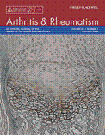Editorial
Tumor necrosis factor receptor–associated periodic syndrome: Toward a molecular understanding of the systemic autoinflammatory diseases
John G. Ryan,
Ivona Aksentijevich,
Corresponding Author
John G. Ryan
National Institute of Arthritis and Musculoskeletal and Skin Diseases, Bethesda, Maryland
Genetics and Genomics Branch, National Institute of Arthritis and Musculoskeletal and Skin Diseases, National Institutes of Health, Building 9 Room 1W108, 9000 Rockville Pike, Bethesda, MD 20892Search for more papers by this authorIvona Aksentijevich
National Institute of Arthritis and Musculoskeletal and Skin Diseases, Bethesda, Maryland
Search for more papers by this authorJohn G. Ryan,
Ivona Aksentijevich,
Corresponding Author
John G. Ryan
National Institute of Arthritis and Musculoskeletal and Skin Diseases, Bethesda, Maryland
Genetics and Genomics Branch, National Institute of Arthritis and Musculoskeletal and Skin Diseases, National Institutes of Health, Building 9 Room 1W108, 9000 Rockville Pike, Bethesda, MD 20892Search for more papers by this authorIvona Aksentijevich
National Institute of Arthritis and Musculoskeletal and Skin Diseases, Bethesda, Maryland
Search for more papers by this author
REFERENCES
- 1 McDermott MF, Aksentijevich I, Galon J, McDermott EM, Ogunkolade BW, Centola M, et al. Germline mutations in the extracellular domains of the 55 kDa TNF receptor, TNFR1, define a family of dominantly inherited autoinflammatory syndromes. Cell 1999; 97: 133–44.
- 2 Galon J, Aksentijevich I, McDermott MF, O'Shea JJ, Kastner DL. TNFRSF1A mutations and autoinflammatory syndromes. Curr Opin Immunol 2000; 12: 479–86.
- 3 Infevers: the Registry of Familial Mediterranean Fever (FMF) and Hereditary Auto-inflammatory Disorders Mutations. Online database for autoinflammatory mutations. URL: http://fmf.igh.cnrs.fr/ISSAID/infevers/.
- 4 Hull KM, Drewe E, Aksentijevich I, Singh HK, Wong K, McDermott EM, et al. The TNF receptor-associated periodic syndrome (TRAPS): emerging concepts of an autoinflammatory disorder. Medicine (Baltimore) 2002; 81: 349–68.
- 5 Wajant H, Pfizenmaier K, Scheurich P. Tumor necrosis factor signaling. Cell Death Differ 2003; 10: 45–65.
- 6 Aganna E, Hammond L, Hawkins PN, Aldea A, McKee SA, van Amstel HK, et al. Heterogeneity among patients with tumor necrosis factor receptor–associated periodic syndrome phenotypes. Arthritis Rheum 2003; 48: 2632–44.
- 7 Huggins ML, Radford PM, McIntosh RS, Bainbridge SE, Dickinson P, Draper-Morgan KA, et al. Shedding of mutant tumor necrosis factor receptor superfamily 1A associated with tumor necrosis factor receptor–associated periodic syndrome: differences between cell types. Arthritis Rheum 2004; 50: 2651–9.
- 8 Siebert S, Amos N, Fielding CA, Wang EC, Aksentijevich I, Williams BD, et al. Reduced tumor necrosis factor signaling in primary human fibroblasts containing a tumor necrosis factor receptor superfamily 1A mutant. Arthritis Rheum 2005; 52: 1287–92.
- 9 Gattorno M, Pelagatti MA, Meini A, Obici L, Barcellona R, Federici S, et al. Persistent efficacy of anakinra in patients with tumor necrosis factor receptor–associated periodic syndrome. Arthritis Rheum 2008; 58: 1516–20.
- 10 Todd I, Radford PM, Draper-Morgan KA, McIntosh R, Bainbridge S, Dickinson P, et al. Mutant forms of tumour necrosis factor receptor I that occur in TNF-receptor-associated periodic syndrome retain signalling functions but show abnormal behaviour. Immunology 2004; 113: 65–79.
- 11 Rebelo SL, Bainbridge SE, Amel-Kashipaz MR, Radford PM, Powell RJ, Todd I, et al. Modeling of tumor necrosis factor receptor superfamily 1A mutants associated with tumor necrosis factor receptor–associated periodic syndrome indicates misfolding consistent with abnormal function. Arthritis Rheum 2006; 54: 2674–87.
- 12 Siebert S, Fielding CA, Williams BD, Brennan P. Mutation of the extracellular domain of tumour necrosis factor receptor 1 causes reduced NF-κB activation due to decreased surface expression. FEBS Lett 2005; 579: 5193–8.
- 13 Lobito AA, Kimberley FC, Muppidi JR, Komarow H, Jackson AJ, Hull KM, et al. Abnormal disulfide-linked oligomerization results in ER retention and altered signaling by TNFR1 mutants in TNFR1-associated periodic fever syndrome (TRAPS). Blood 2006; 108: 1320–7.
- 14 Todd I, Radford PM, Daffa N, Bainbridge SE, Powell RJ, Tighe PJ. Mutant tumor necrosis factor receptor associated with tumor necrosis factor receptor–associated periodic syndrome is altered antigenically and is retained within patients' leukocytes. Arthritis Rheum 2007; 56: 2765–73.
- 15 Rebelo SL, Amel-Kashipaz MR, Radford PM, Bainbridge SE, Fiets R, Fang J, et al. Novel markers of inflammation identified in tumor necrosis factor receptor–associated periodic syndrome (TRAPS) by transcriptomic analysis of effects of TRAPSassociated tumor necrosis factor receptor type I mutations in an endothelial cell line. Arthritis Rheum 2009; 60: 269–80.
- 16 Drewe E, Powell R, McDermott E. Comment on: failure of anti-TNF therapy in TNF receptor 1-associated periodic syndrome (TRAPS). Rheumatology (Oxford) 2007; 46: 1865–6.




